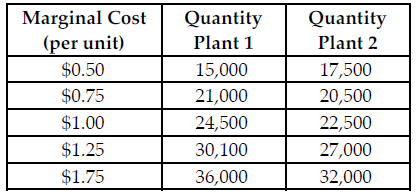The Robinson-Patman Act of 1936:
A. prohibited selling products at "unreasonably low prices" with the intent of reducing competition.
B. made it illegal to monopolize a market.
C. repealed the Sherman Act.
D. outlawed price discrimination for the purpose of reducing competition.
Answer: A
You might also like to view...
An externality refers to an economic event which takes place outside of a market
Indicate whether the statement is true or false
Refer to the table below. If Sweet Grams is a perfectly competitive firm and the market price $1.25 per unit, what is the profit-maximizing total quantity for Sweet Grams to produce?

Sweet Grams makes graham cracker snack packages. Sweet Grams is a multi-plant firm with two production facilities. The above table summarizes the total marginal cost of production at various output levels in the separate plants. Assume Sweet Grams is a perfectly competitive firm.
A) 27,000
B) 30,100
C) 57,100
D) 68,000
Which of the following is an example of a capital resource?
a. a bank loan b. a corporate bond c. a tractor used by a farmer d. a lawn tractor used by a household e. 100 acres of prime farmland
Bob and Mary each have a Ph.D. in economics. Bob has a job in private industry at which he earns $90,000 a year. Mary earns half that much as a college professor. Which of the following could not explain Mary's career choice?
a. She experiences diminishing marginal utility. b. She enjoys the flexibility of her schedule. c. She enjoys teaching. d. She enjoys the informal atmosphere of a college. e. She likes having her summers free to do research.